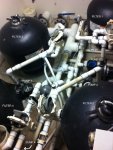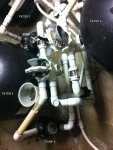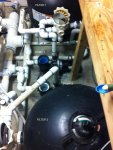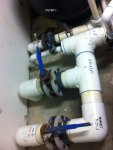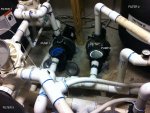My post has some elements that may supersede this particular forum. But, I will put it all out there and hopefully not get flamed on my first post. :lol:
I look after a 120,000 gallon pool in my neighborhood. We have a pool management company that does all maintenance and upkeep. For this upcoming pool season, I am hiring a new pool management company. As a part of that new agreement, I am looking to make some changes to the pool. First off, the pool needs to be re-surfaced. It has been about 10 years and it is in bad need. That decision has been made, and is not the topic of my post. We are going with a DiamondBrite exposed aggregate surface of some type.
We currently have four sand filters and four 2hp pumps currently. Chlorination is via a stick chlorinator feeder. We switched from liquid chlorine two years ago when the last pool company suggested that the liquid chlorine was dangerous and less efficient. I have found that is not necessarily true, but like most things with pools, everyone has a different opinion. Every year, I replace at least one pump, sometimes two. I have gotten mixed advice on why that is happening. My best guess is that I am getting failures because the plumbing configuration is causing a situation where the pumps are fighting each other. Some pumps win out and the ones that don't are getting air in them, losing prime and are more frequently prone to death. Strictly a theory, but I have seen the lost prime problem happen with my own eyes.
So, as we head in to this season, I am looking at doing one of three things:
1) Nothing - Keep the system in the same configuration. Replace pumps as necessary.
2) Keep the four pump, four filter system, but re-evaluate the plumbing to make it more efficient.
3) Switch to a one pump system (i assume keeping the four filters).
4) Switch to a salt-generator system and replace the necessary plumbing.
So, my dilemma is which option to choose. I have looked through this forum and have found good, yet conflicting information. Is there anyone skilled in the art of pool pump configuration that can give me some advice and guidance. I am looking for something to help me decide against the two vendors I am looking at.
One of the vendors is against salt and says I will have problems after two years. He also indicated that I should really switch back to liquid chlorine instead of the stick feeder. The other vendor is pro-salt and indicates that with periodic cleaning, a good salt system will last a long time. The pro-salt guy is not pushing it as much as I am wanting it, but will be proposing some pump configuration changes shortly.
Any advice from the forum would be greatly appreciate.
I look after a 120,000 gallon pool in my neighborhood. We have a pool management company that does all maintenance and upkeep. For this upcoming pool season, I am hiring a new pool management company. As a part of that new agreement, I am looking to make some changes to the pool. First off, the pool needs to be re-surfaced. It has been about 10 years and it is in bad need. That decision has been made, and is not the topic of my post. We are going with a DiamondBrite exposed aggregate surface of some type.
We currently have four sand filters and four 2hp pumps currently. Chlorination is via a stick chlorinator feeder. We switched from liquid chlorine two years ago when the last pool company suggested that the liquid chlorine was dangerous and less efficient. I have found that is not necessarily true, but like most things with pools, everyone has a different opinion. Every year, I replace at least one pump, sometimes two. I have gotten mixed advice on why that is happening. My best guess is that I am getting failures because the plumbing configuration is causing a situation where the pumps are fighting each other. Some pumps win out and the ones that don't are getting air in them, losing prime and are more frequently prone to death. Strictly a theory, but I have seen the lost prime problem happen with my own eyes.
So, as we head in to this season, I am looking at doing one of three things:
1) Nothing - Keep the system in the same configuration. Replace pumps as necessary.
2) Keep the four pump, four filter system, but re-evaluate the plumbing to make it more efficient.
3) Switch to a one pump system (i assume keeping the four filters).
4) Switch to a salt-generator system and replace the necessary plumbing.
So, my dilemma is which option to choose. I have looked through this forum and have found good, yet conflicting information. Is there anyone skilled in the art of pool pump configuration that can give me some advice and guidance. I am looking for something to help me decide against the two vendors I am looking at.
One of the vendors is against salt and says I will have problems after two years. He also indicated that I should really switch back to liquid chlorine instead of the stick feeder. The other vendor is pro-salt and indicates that with periodic cleaning, a good salt system will last a long time. The pro-salt guy is not pushing it as much as I am wanting it, but will be proposing some pump configuration changes shortly.
Any advice from the forum would be greatly appreciate.


